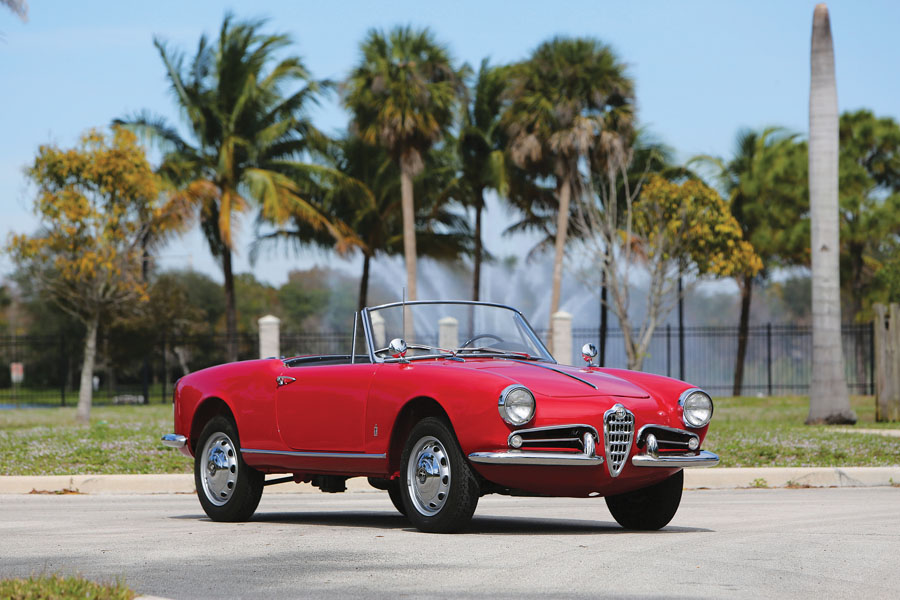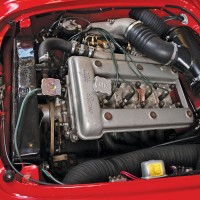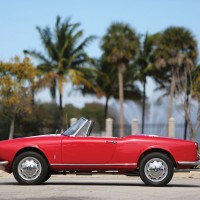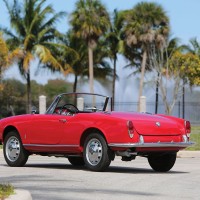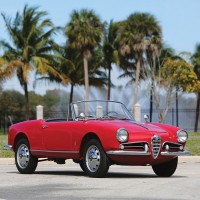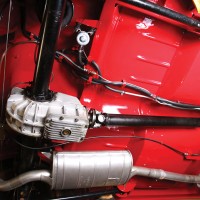SCM Analysis
Detailing
| Vehicle: | 1962 Alfa Romeo Giulietta Spider Veloce |
| Years Produced: | 1959–62 |
| Number Produced: | 500 (estimated) |
| Original List Price: | $3,450 |
| SCM Valuation: | Median to date, $70,000; high sale, $85,000 |
| Tune Up Cost: | $375 |
| Chassis Number Location: | Engine bulkhead, on plate and stamped into body |
| Engine Number Location: | Intake side of block |
| Club Info: | Alfa Romeo Owners Club |
| Website: | http://www.aroc-usa.org |
| Alternatives: | 1962 Porsche 356B cabriolet, 1962 Fiat 1600S convertible, 1962 Facel Facellia, 1963 ASA 1000 Spider |
| Investment Grade: | B |
This car, Lot 503, sold for $82,500, including buyer’s premium, at the Auctions America Fort Lauderdale, FL, sale on April 2, 2016.
As real estate is all about “location, location, location,” so Alfa Romeos from the 1920s through the 1960s are all about “specification, specification, specification.” Alfa always made interesting cars, but also frequently made single-carburetor versions that seemed poky when you compared them with their multi-carb, high-strung sizzling sisters.
In the early days the ladder was longer to climb, from Turismo (slow), through Sport (certainly adequate), to Super Sport, which was the hot ticket. In the new, populist Alfa of the mid- to late-1950s Giulietta, things were boiled down to Normale — literally, “normal” and “Veloce” — literally, “fast.” I think you can figure out which one most folks want.
Normal is pretty good
There is certainly nothing wrong with a normal Alfa. I was blessed enough to participate in the 2015 Mille Miglia as co-driver and driver in a fantastic 1956 Giulietta Sprint Normale — one of the early column-shift models. It had all the get-up-and-go needed to cover ground on the flat and in the mountains quite well, thank you very much, and of course, it still rode and handled like the thoroughbred it was created to be. It also wasn’t at all fussy when stuck in city traffic jams, and it never fouled a plug.
It has also been long a habit in the Mondo Alfa to be perfectly accepting of cars whose specifications have been uprated. There are very few — if any — visual differences between generations of twin-cam Alfa engines, and later 5-speed gearboxes are readily accommodated in cars built with four cogs. There’s even an official name in Alfadom for a humble Normale that graduates from the shop as a sexy Veloce. The name is “Abnormale.” I report; I don’t judge.
Today, as an inevitable side effect of steadily rising prices, now there are collectors who insist on originality in specification and frown on repair shop creativity.
As such, a premium is generally paid for cars that are unquestionable examples of the high-performance variant. We should assume that this car is a genuine Veloce as stated, with its 2,000-rpm tachometer, 140-mph speedometer and ID plates and engine number.
New tags a concern
What does give me pause are a few items. The car appeared to carry an engine number which was the correct 106 type but with a production number outside of that listed for 1962 in the Luigi Fusi bible: Alfa Romeo All Cars from 1910. There are certainly acknowledged errors and omissions in the Fusi book, and full record keeping was not a strong point in Italian factories during the 1950s and ’60s.
Further, however, in the catalog description a list of the identifying characteristics of the Veloce is given. Among them is the presence of an “F” stamped into the firewall with the chassis number. The photo of the firewall stamping didn’t appear to show the F. The ID tag carrying the type number 101.07 Veloce identification should be riveted to the firewall. All the ID tags on this car — with the exception of the “Alfa Romeo Made in Italy” tag — were reproduction items, newly stamped and attached with a variety of both flat- and Phillips-head screws.
I don’t understand why so many restorers choose to replace worn, original ID tags with new ones. It’s deliberately erasing one of the most important points of a vehicle’s identity. I would much rather see the factory’s work — even faded and scratched — inside the freshly painted engine room. I didn’t attend the sale, so I could only analyze this car from the catalog description and online photographs.
What I saw was a very shiny example with beautifully restored instruments that also showed a few notable issues, such as a higher-than-correct ride height and somewhat casual fit on some body panels and trim.
Fresh out of the resto shop
Publisher Martin drove this car during the preview as part of his duties as co-host of his TV show “What’s My Car Worth?” He opined that it “seemed very clean, fresh from the restoration shop,” but also that it “pulled strongly to the right under braking and in general felt like a car that had just been finished and hadn’t yet been made ‘a car.’”
The current market handsomely rewards well-documented, perfectly preserved or restored examples of desirable cars. Ready buyers compete to obtain such vehicles, while those that are less satisfying are available at a considerable discount. The current SCM Pocket Price Guide lists a median price of $70k and a high-sale price of $85k for this model. As such, this would place our subject near the top of the range.
I am aware of private sales of late Giulietta Veloce Spiders for over $100k. Of course, earlier, more-vintage-event-eligible 750 Series Normales and Veloces regularly command much above the $100k mark. Given the level of preparation of this car and the unfortunate replacement of the original ID tags with reproductions, I would call this well sold.
If the questions answer correctly, no harm will be done to the buyer who bought this car to sort out and enjoy in spirited driving as it was intended. ♦
(Introductory description courtesy of Auctions America)
